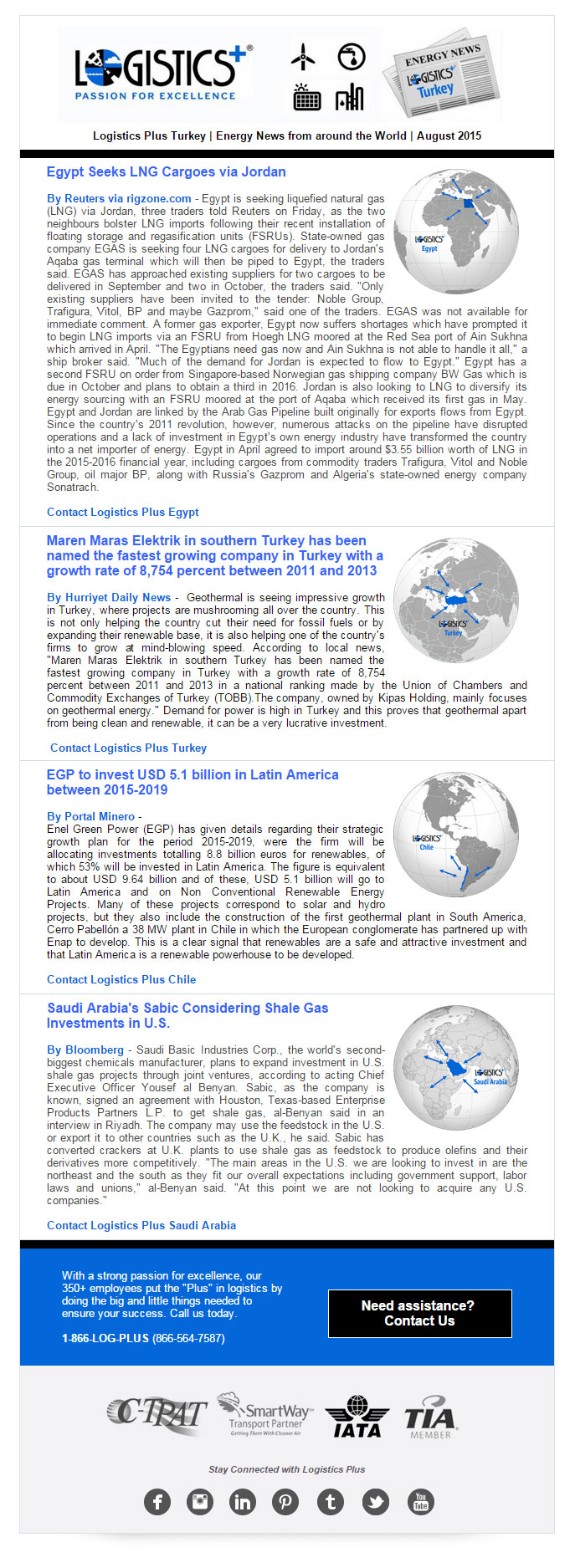
by Scott Frederick | Aug 26, 2015 | News
 Energy News from around the World
Energy News from around the World
Today Logistics Plus Turkey (aka, LP Turkey) sent its second issue of LP Turkey Energy News to customers and other interested parties throughout the region. The new issue is pictured below. Click here to read the online version.


by Scott Frederick | Aug 21, 2015 | News
 Earlier this month, Logistics Management magazine unveiled the results of its 32nd Annual Quest for Quality Awards recognizing some of the highest-quality carriers in the industry. This year, its survey results yielded 125 providers of transportation and logistics services. To determine who wins the vote, Logistics Management readers evaluate companies in all modes and service disciplines, choosing the top performers in categories including motor carriers, railroad and intermodal services, ocean carriers, airlines, freight forwarders, ports, third-party/contract logistics services.
Earlier this month, Logistics Management magazine unveiled the results of its 32nd Annual Quest for Quality Awards recognizing some of the highest-quality carriers in the industry. This year, its survey results yielded 125 providers of transportation and logistics services. To determine who wins the vote, Logistics Management readers evaluate companies in all modes and service disciplines, choosing the top performers in categories including motor carriers, railroad and intermodal services, ocean carriers, airlines, freight forwarders, ports, third-party/contract logistics services.
Logistics Plus, being a smaller-sized third-party logistics company, was not included on the survey ballot (but we’ll see if we can change that in the coming years). However, many of our core LTL freight carriers were on the ballot and many also won awards. So we’d like to congratulate the following Logistics Plus LTL freight carriers for winning Quest for Quality Awards this year:
- FedEx Freight (National and Multiregional LTL categories)
- Con-way Freight (National LTL category)
- Holland (Midwest/North Central LTL, South/South Central LTL and Expedited categories)
- Pitt Ohio (Northeast/Mid-Atlanta LTL category)
- New Penn (Northeast/Mid-Atlanta LTL and Expedited categories)
- A. Due Pyle (Northeast/Mid-Atlanta LTL and Expedited categories)
- Southeastern Freight Lines (South/South Central LTL category)
- Reddaway (Western LTL category)
Additionally, there were a number of truckload, expedited, ocean and air freight carriers that Logistics Plus has worked with in the past year that won Quest for Quality awards, including Miller Transporters, Ruan Transport, Prime, Landstar, and J.B. Hunt (truckload carriers); Panther Premium Logistics and FedEx Custom Critical (expedited motor carriers); Maersk Line, Hapag-Lloyd, Evergreen Line, OOCL, and COSCO (ocean carriers); and Cathay Pacific, British Airways, Delta Air Lines, Korean Air, Lufthansa, Emirates SkyCargo, and FedEx Express (airfreight carriers).
Reputable and quality carriers not already a part of the Logistics Plus network can click the button on the left below to start the process of becoming a carrier. Shippers looking for quality carriers through a third-party logistics partner can click the button on the right below to request a risk-free quote.


by Scott Frederick | Aug 14, 2015 | Testimonials
 Bhavna and the Logistics Plus international team in Dallas helped so much during the West Coast port shut downs. They gave a lot of time and attention to coordinating our container moves, taking into consideration move time and cost. We really appreciate their continued efforts and great service!
Bhavna and the Logistics Plus international team in Dallas helped so much during the West Coast port shut downs. They gave a lot of time and attention to coordinating our container moves, taking into consideration move time and cost. We really appreciate their continued efforts and great service!
Customer Service Manager
Expolinc Corporation

by Scott Frederick | Aug 14, 2015 | News
India is celebrating its 69th year of Independence this month. India became an independent nation on August 15, 1947. Independence Day in India is a day when Indian people pay homage to their leaders and those who fought for India’s freedom in the past. The period leading up to Independence Day is a time when major government buildings are illuminated with strings of lights and the tricolor flutters from homes and other buildings. In honor of this great holiday, the Logistics Plus (LP) employees in New Delhi, pictured below, joined in on the celebrations.


With six locations across India, Logistics Plus is fully committed to helping businesses with their transportation and logistics within, to and from India. We specialize in project cargo, air and ocean freight forwarding, warehousing, and ground or rail transportation. With our 4PL solutions, we can also help businesses manage their entire supply chain using dedicated resources and technology. Please click the button below to request more information about our India logistics solutions.

You can read more about India Independence Day on timeanddate.com or at independenceday.nic.in

by Scott Frederick | Aug 12, 2015 | News
 As we announced back on July 7, Logistics Plus was named a 2015 Great Supply Chain Partner by SupplyChainBrain magazine. The official July/August magazine article came out earlier this week. A copy of the article and the official, final listing of top supply chain partners also appears on the SupplyChainBrain.com website. The article points out that no company and no supply chain exists in a vacuum. Shippers and logistics partners rely on each other because ‘no one of us can do it all, successfully, ourselves.’ We all need partners – but which ones are right for your company or supply chain?
As we announced back on July 7, Logistics Plus was named a 2015 Great Supply Chain Partner by SupplyChainBrain magazine. The official July/August magazine article came out earlier this week. A copy of the article and the official, final listing of top supply chain partners also appears on the SupplyChainBrain.com website. The article points out that no company and no supply chain exists in a vacuum. Shippers and logistics partners rely on each other because ‘no one of us can do it all, successfully, ourselves.’ We all need partners – but which ones are right for your company or supply chain?
According to the SupplyChainBrain authors, when they looked closely at all of this year’s ‘Great Supply Chain Partner’ nominations carefully, they found the following top ten challenges on readers’ minds with regard to issues that their supply chain partners help them solve:
- Reliability – Meaning well is not enough; hope is not a business model.
- Excellence – If they don’t have this upfront, should they be your partner?
- Value – Seriously, what does your potential partner bring to the table?
- Expertise – Give me a partner who knows my business – and something I don’t already know.
- Problem-solver – You deserve a proactive partner, not one looking to you for the answers.
- Continuous improvement – Does your partner value ongoing education?
- Support – Your partner needs to support you well after the sale is done or the implementation is finished.
- Positive attitude – You need a partner who sees challenges as opportunities.
- Global reach – You can’t conquer the world if you have a stay-at-home partner.
- Strong leadership – What’s required is much more than Leadership 101.
We here at Logistics Plus remain very proud of being both nominated and recognized as a 2015 Great Supply Chain Partner. Our ability and flexibility to address many of the supply chain challenges listed above is clearly a primary reason we were chosen for the list. Although we don’t know for sure which of our customers actually nominated us, we do continue to receive many testimonials that confirm our status as a great supply chain partner, including recent ones from a solar industry manufacturing company and a shelter systems relief organization.
Feel free to read the full SupplyChainBrain article online, check out the full 2015 Great Supply Chain Partner list, or contact Logistics Plus if you have a supply chain challenge of your own that you’d like us to help you with (just click the button below).


 Energy News from around the World
Energy News from around the World




 Bhavna and the Logistics Plus international team in Dallas helped so much during the West Coast port shut downs. They gave a lot of time and attention to coordinating our container moves, taking into consideration move time and cost. We really appreciate their continued efforts and great service!
Bhavna and the Logistics Plus international team in Dallas helped so much during the West Coast port shut downs. They gave a lot of time and attention to coordinating our container moves, taking into consideration move time and cost. We really appreciate their continued efforts and great service!



